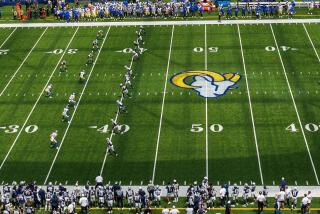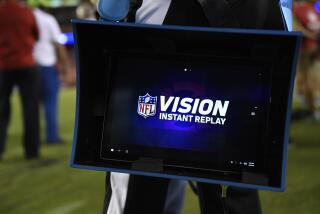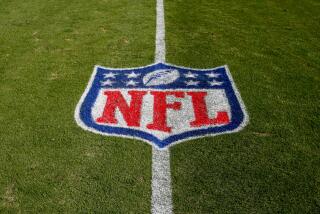NHL Initiatives May Open Way to Faster, More Skillful Play : Hockey: Referees are under orders to continue clamping down on obstruction fouls.
- Share via
The NHL’s new focus on obstruction fouls resulted in a deluge of penalty calls in exhibition games--and sparked criticism that the continuity of play suffered--but referees were told not to soften their approach when the season begins tonight.
“Players will adapt to the standard, or they’d better have the best penalty-killing units in the league,” said Brian Burke, the NHL’s director of hockey operations. “The standard is not negotiable. The standard will not be relaxed. We’re encouraged by what we’ve been seeing. This is a positive change for the league.”
Obstruction fouls are generally hooking, holding and grabbing onto an opponent, tactics players use to compensate for lack of skill or poor positioning. Heeding complaints that skilled players were being hampered and the game was being slowed, the NHL formed a committee that clarified existing rules and recommended their tighter application.
Referees took the directive to heart during exhibition play, and the result often was ugly. Teams commonly combined for as many as 29 power plays per game and coaches had difficulty evaluating players because they had to deploy their special teams so often.
“It’s obviously an educational process for the players and a matter of self-discipline,” Washington Capital Coach Jim Schoenfeld said. “Now, players realize what’s going to be called, and they have to break some old habits. It takes away from the offensive flow.”
Said Mighty Duck Coach Ron Wilson: “It’s painful. It’s painful for the players and coaches. It’s painful for the fans. But it will make our game a better game.”
In the 105 exhibition games for which the NHL has complete reports, the average number of penalties was 22.6 per game, including an average of 18.5 minor penalties. Of those penalties, an average of 6.4 per game were obstruction calls. NHL spokesman Gary Meagher estimated the average penalty minutes per game at slightly more than 50 for the first two weeks’ games.
The average number of penalties per game last season was 14, including an average of 11.5 minor penalties. The average number of penalty minutes per game was 39.3.
New York Ranger General Manager Neil Smith, a member of the obstruction committee, believes referees carried out the committee’s intent.
“You’re trying to get players to adjust to a new standard. Instead of just skating back and locking onto a guy and not skating himself, the guy has to skate and keep up,” Smith said recently. “What we’re seeing now is just the adjustment period. Players have been doing it [obstructing opponents] for so long and the coaches have been teaching it for so long, it takes a while to get used to new situations.
“What we really had in mind was to stop the paralysis that could be put onto skill players and on the game in general. So many times you’d see a defenseman come in and it’s the other guy’s job to take the opposing forechecker into the boards or lock him up in the neutral zone. Skill players love this. Players like [Ranger winger Luc] Robitaille and [Winnipeg winger Teemu] Selanne, people who can do things, they’ll benefit.”
Burke also anticipates the number of penalties to drop as players learn the new limits. In exhibitions, obstruction calls decreased from an average of 8.6 per game during the first week to 6.9 before finishing at 6.4.
“There’s no question that players will adjust and that the hockey played between penalties, when they’re aware of the standard, has had a better flow, more offense, more speed, more hitting,” said Burke, who encourages referees to talk to coaches and to explain calls to players during games. “And we think the standard will reward and highlight skill players in the league and bring the little guy back in. . . .
“We’re trying to change 15 years of hockey culture in three weeks. We’ve gotten to the point where coaching has taken obstruction to an art form. It’s not easy to change.”
King defenseman Rob Blake said he often had to make a conscious effort to stay within the redefined rules.
“I caught myself a few times, when there was a guy going by me, and before I would just reach out and hang onto him, but you can’t do that now,” he said. “Definitely, it’s something you learn. You’re taught to play one way over the years and now you have to learn something else. I like it. I think it’s going to speed the game up. You have to rely on your skating now.”
Said Ranger goalie Mike Richter: “You’re going to have to work harder and get your feet moving and get good body position because you can’t use your stick. I think every team is going to have to make changes, and whoever adjusts quicker and better is going to have an advantage.”
More to Read
Go beyond the scoreboard
Get the latest on L.A.'s teams in the daily Sports Report newsletter.
You may occasionally receive promotional content from the Los Angeles Times.







